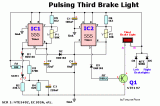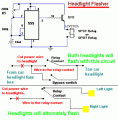Pushbutton activated
Very simple circuitry
Parts:
R1 4K7 1/4W Resistor
R2,R3 1K 1/4W Resistors
C1 100µF 25V Electrolytic Capacitor (See Notes)
D1 1N4002 100V 1A Diode
Q1 BC547 45V 100mA NPN Transistor
Q2 BC327 45V 800mA PNP Transistor
P1 SPST Pushbutton
RL1 Relay with SPDT 10A min. switch
Coil Voltage 12V. Coil resistance 150-600 Ohms
Comments:
This device is a simple timer, allowing to keep on the headlights of your vehicle for about 1min. and 30sec., e.g. when accessing some dark place, without the necessity of coming back to switch-off the lights.
Circuit operation:
Pushing on P1 allows C1 charging to full 12V battery supply. Therefore Q1 is driven hard-on, driving in turn Q2 and its Relay load. The headlights are thus activated by means of the Relay contact wired in parallel to the vehicle's headlights switch. RL1 remains activated until C1 is almost fully discharged, i.e. when its voltage falls below about 0.7V.
The timing delay of the circuit depends by C1 and R1 values and was set to about 1min. and 30sec.
In practice, due to electrolytic capacitors wide tolerance value, this delay will vary from about 1min. and 30sec. to 1min. and 50sec.
An interesting variation is to use the inside lamp as a command source for the timer. In this way, when the door is opened C1 is charged, but it will start to discharge only when the door will be closed, substituting pushbutton operation.
To enable the circuit acting in this way, simply connect the cathode of a 1N4002 diode to R1-C1 junction and the anode to the "live" lead of the inside lamp.
This lead can be singled-out using a voltmeter, as it is the lead where a 12V voltage can be measured in respect to the vehicle frame when the lamp is on.
Notes:
The Relay contact must be rated at 10A or more.
Timings obtained trying different tolerance electrolytic capacitors for C1:
100µF = 1'30" to 1'50"
47µF = 0'45" to 1'05"
220µF = 3'15" to 4'15"
Author: RED Free Circuit Designs
Email:
Website: http://space.tin.it/scienza/fladelle/

 Audio
Audio




